![]()
![]()
![]()
Use LEFT and RIGHT arrow keys to navigate between flashcards;
Use UP and DOWN arrow keys to flip the card;
H to show hint;
A reads text to speech;
34 Cards in this Set
- Front
- Back
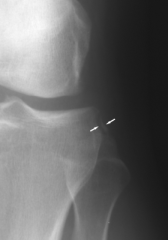
1what do I see on this image, findings, importance ?
|
Segond sign
Small tibial avulsion fracture that indicates a ACL tear |
|
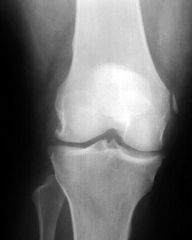
1what do I see on this image, findings, importance ?
|
Pellegrini Stieda Sign
Medial femoral condyle avulsion fx (Chronic MCL injury) |
|
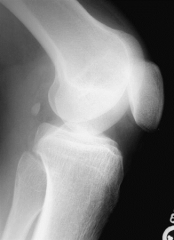
super "7": (3) what do I see on this image, findings, importance ?
|
Patella baja
Arthrofibrosis |
|
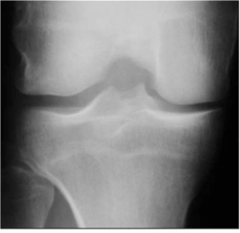
super "7": (3) what do I see on this image, findings, importance ? horse
|
Fairbanks changes
DJD - post meniscectomy 1(square condyle, 2peak eminences, 3ridging, 4narrowing |
|
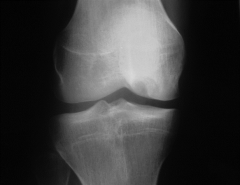
super "7": (3) what do I see on this image, findings, importance ?
|
Lateral MFC lesion
OCD |
|
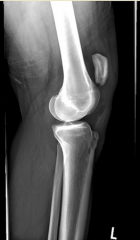
super "7": (3) what do I see on this image, findings, importance ?
|
Patella alta patella tendon rupture
|
|
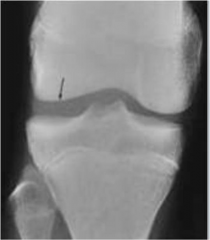
super "7": (3) what do I see on this image, findings, importance ?
|
Square lateral condyle
Discoid meniscus |
|

super "7": (3) what do I see on this image, findings, importance ?
|
3 sagittal MRI images
Discoid meniscus |
|
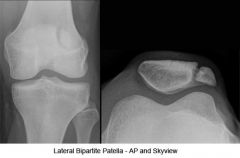
super "7": (3) what do I see on this image, findings, importance ?
|
Bipartate patella most common location--superior lateral , b/l common
Must differentiate from fracture |
|
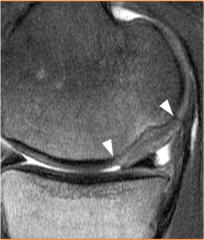
super "7": (3) what do I see on this image, findings, importance ?
|
Lateral MFC lesion
OCD |
|
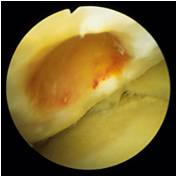
super "7": (3) what do I see on this image, findings, importance ?
|
Lateral MFC lesion OCD
|
|
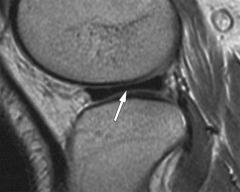
super "7": (3) what do I see on this image, findings, importance ?
|
sagittal MRI images
Discoid meniscus |
|
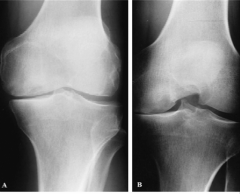
super "7": (3) what do I see on this image, best for findings, importance ? type of x-ray
|
45 degree PA flexion view
best for early tibio-femoral arthritis, posterior wear |
|
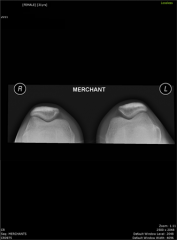
super "7": (3) what do I see on this image, best for findings, importance ? type of x-ray
|
Merchant or sunrise view
to evaluate patello-femoral space, tilt and alignment |
|
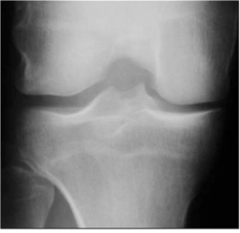
super "7": (3) what do I see on this image, best for findings, importance ? type of x-ray
|
Standard Radiographs
Weight-bearing preferred for evaluation of joint space. |
|
|
two diagnostic indications Varus-valgus stress radiographs?
|
physeal fractures in children
MCL / LCL injuries |
|
|
two diagnostic indications Posterior stress radiographs ?
|
isolated PCL injury (10-12 mm posterior displacement)
PCL and PLC injury (> 12 mm posterior displacement) |
|
|
how does one shoot 45 degree PA flexion view
|
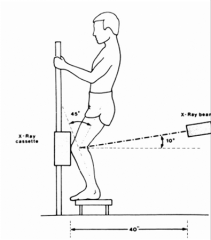
|
|
|
what are 3 views of mri,
why get a MRI |
sagital-meniscal injury, ligament tear bone bruise
coronal PLC corner injuries axial |
|
|
super "7": (3) why get sagital, findings, importance ?
|
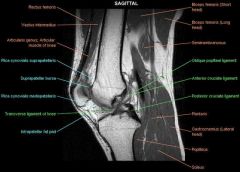
sagittal
evaluate menisci, cruciates, cartilage, extensor mechanism |
|
|
super "7": (3) why get coronal findings, importance ?
|
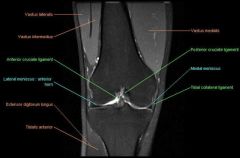
coronal
evaluate menisci, cruciates, collaterals, cartilage |
|
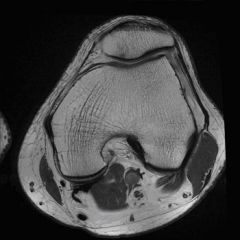
super "7": (3) why get this view, which is it findings, importance ?
|
axial
evaluate patellofemoral joint, cruciates, popliteal fossa |
|
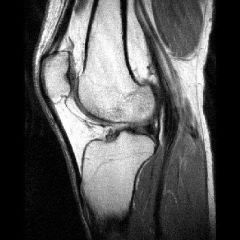
super "7": (3) what do I see on this image, best for findings, importance ?
|
T1
water dark, fat bright best for showing anatomy, but not pathology |
|
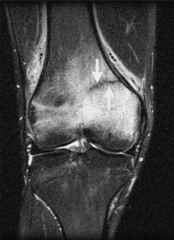
super "7": (3) what do I see on this image, best for findings, importance ?
|
T2
fat dark, water bright well suited for imaging edema and pathology |
|

super "7": (3) what do I see on this image, best for findings, importance ?
|
T2
fat dark, water bright well suited for imaging edema and pathology |
|
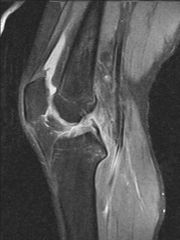
super "7": (3) what do I see on this image, best for findings, importance ?
|
STIR (Short T1 Inversion Recovery) Images
fat suppression technique improved quality imaging in the presence of orthopedic prostheses |
|
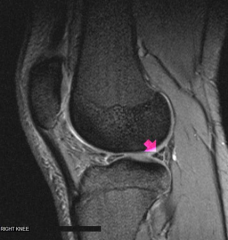
super "7": (3) what do I see on this image, findings, importance ?
|
meniscal injury
Medial meniscal extrusion >3mm is associated with severe meniscal degeneration, a large meniscal tear, or tear of the root Radial meniscal tears are more common in patients following prior meniscal surgery (32% prevelance of radial meniscal tears in post-op knees compared to 14% in patients without prior surgery) |
|
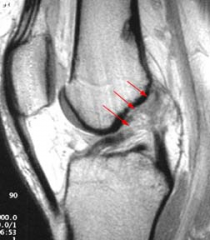
super "7": (3) what do I see on this image, findings, importance ?
|
ligament tear
Increased signal intensity, thickening, and cysts within and adjacent to ACL are common findings, and clinically insignificant (no instability) |
|
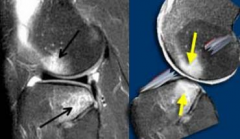
super "7": (3) what do I see on this image, findings, importance ?
|
bone bruise
near sulcus terminalis osteochondral injury |
|
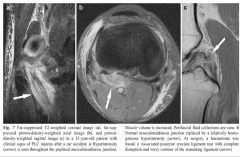
super "7": (3) what do I see on this image, findings, importance ?
|
PLC corner injuries
can routinley visualize LCL and popliteus tendon with MRI, other structures are more rarley seen edema posterior to popliteus tendon can indicate an injury to the underlying structures of the PLC |
|
|
3.0 T MRI has accuracy, sensitivity, and specificity of >90% for detecting?
|
>90% for detecting medial and lateral meniscus tears
|
|

super "7": (3) what do I see on this image, findings, importance ?
|
PLC corner injuries
can routinley visualize LCL and popliteus tendon with MRI, other structures are more rarley seen edema posterior to popliteus tendon can indicate an injury to the underlying structures of the PLC |
|
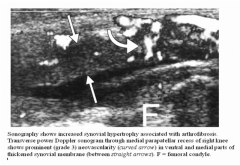
super "7": (3) what do I see on this image, findings, importance ?
|
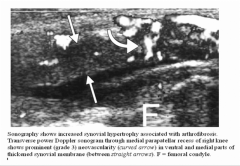
Excellent for
fluid collections useful to evaluate bursae and fluid collections about the knee arthrofibrosis effective in detecting arthrofibrosis of the knee following TKA key findings for arthrofibrosis are synovial thickening and neovascularity |
|
|
Which of the following radiographic views is most sensitive for detecting knee joint degenerative changes?
|
The 45 degree PA flexion weightbearing view is the best for demonstrating subtle joint-space loss, especially in the lateral compartment. This is because the earliest loss of cartilage occurs in the 30 to 60 degree flexion zone which is easily overlooked on x-rays in full extension.
"the screening radiograph of choice in evaluating osteoarthritis of the knee". |

